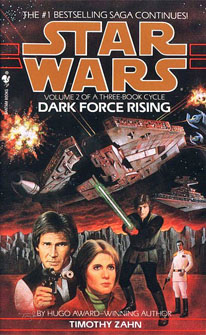Obi-Wan Kenobi’s offhand mention of the Clone Wars in “Star Wars” set off years of speculation that was finally, officially brought to rest with 2002’s “Attack of the Clones.” But it’s easy to forget that Timothy Zahn tackled the idea of clones in 1992’s “Dark Force Rising,” the second book of the Thrawn trilogy.
This year marks the 20th anniversary of “Dark Force Rising,” and although there will be no annotated special edition as there was for “Heir to the Empire” last year, I re-read it anyway and found it to be superior to its predecessor. Luke’s realization that Thrawn has access to old cloning technology (Spaarti cloning cylinders) — plus more hints that insane Jedi Master Joruus C’baoth is a clone — is an awesome cliffhanger precisely because clones were such a big, yet unexplored, part of “Star Wars” lore at that time.
But first, the centerpiece of “Rising” is the race for the Katana Fleet, a.k.a. the Dark Force. It was mentioned offhand in “Heir,” but here it takes the spotlight, starting with Karrde telling Mara the story of a slave-circuited Old Republic fleet that jumped to lightspeed and was lost. Even though I thought this would lead into a “Where’s the Katana Fleet?” mystery, I like how Mara picks up on where Karrde’s going, shifting the tenor immediately: “So how did you happen to find it?”
Admittedly, it’s a contrivance that Han and Lando’s adventure also leads them to the Katana Fleet. One other person besides Karrde knows about the fleet (this man’s name is Captain Hoffner, although that will be news to me every time I re-read the book, because we never actually meet the guy and he remains a cipher). Han and Lando meet with an early Rebellion bigwig (Senator Garm Bel Iblis) who wants to rejoin the fight against the Empire, and he just happens to own some ships that were originally part of the Katana Fleet.
Still, it all builds up to a worthy conclusion where the New Republic and the Empire race to acquire the fleet in order to gain a huge edge in the war.
“Dark Force Rising” delves to a remarkable degree into the prequel era, and it’s impressive that Zahn doesn’t contradict too much of what we’d later learn in the films (and the contradictions we do get are fascinating in retrospect). Here, we find out that Mon Mothma was an early founder of the Rebellion, although the details aren’t exactly like the “Revenge of the Sith” novelization (where Padme is involved in the early days) and the events of “The Force Unleashed” (where Darth Vader forms the Rebellion). Rather, Zahn writes of three resistance groups that came together to form the Rebel Alliance, signing the Corellian Treaty to formalize it; Mothma became the figurehead, with Bail Organa and Bel Iblis relegated to the background.
Also, Luke researches Jorus C’baoth (he doesn’t know the modern-day C’baoth is a clone) in the Old Senate Library and learns a remarkable amount about the man’s Jedi training considering how little he knows about his own family’s history. (It’s not a plot hole, necessarily. One could assume that the Old Senate Library’s records on the Jedi are more generalized, so it might even include some basics about Anakin Skywalker, Obi-Wan and Yoda that Luke does indeed have access to. However, the meatier stuff about Anakin — the stuff that would give Luke a good picture of what his father was like — would have been in the Jedi Archives, and those would’ve been destroyed during the Empire’s takeover of Coruscant’s government buildings and records.)

Finally, Leia — investigating the conditions of the Noghri planet Honoghr under Imperial rule — realizes that the plant life was destroyed not during the Rebellion, but during the Clone Wars, thus giving her evidence that the Empire has been poisoning the planet rather than re-seeding it. “Forty-four years,” Leia says in disbelief. As with “Heir to the Empire,” Zahn was working with faulty information, provided by Lucasfilm, of when the Clone Wars took place. So all of his Clone Wars dates are about 10 years older than what they should be. (Side note: Wouldn’t it be cool to see the battle that savaged Honoghr in a “Clone Wars” TV arc?)
It’s also intriguing that the clones, in Zahn’s words, “felt strange to (Luke’s) mind.” I don’t recall this notion ever being explored in Clone Wars-era fiction, where the Jedi generals work so closely with their clone counterparts. I think Jedi Etain in Karen Traviss’s “Republic Commando” books talks about how the clones gives off similar, yet subtly different, impressions. However, I don’t recall the notion of “strangeness” being carried beyond Zahn’s books. Then again, that’s not necessarily an inconsistency, because we already know that the Kamino clones are not the same as the Spaarti clones; these were two different projects put forth by Palpatine, and presumably, the Kamino technology was better. (And is the cloning in “Dark Empire” — where the Emperor grows clones of himself in order to take over the bodies with his essence — yet a third example of cloning technology? I’ll have to add those comics to my re-reading list.)
“Dark Force Rising” daringly, slyly delves into the prequel era through its use of clones and an ancient Jedi and references to the Clone Wars. This is what made it a compelling read in 1992 and such an interesting curiosity today. Although some details are wrong, there’s nothing so egregiously off base that it takes you out of the flow of the story. Zahn understands that the Old Republic became the Empire — this bit of information dates all the way back to the opening of the “Star Wars” novelization, so it’s just a matter of being well-read, not prescient. However, the big twist of “Attack of the Clones” — that the clones fought on the side of the Old Republic, not against it — was made possible because of a wrong assumption by many fans, and it’s interesting to note that Zahn never makes that wrong assumption. Indeed, Thrawn’s coveted Spaarti cloning cylinders are stored in the Emperor’s warehouse.
Although I notice the contrivances more on this re-reading project, “Dark Force Rising” is just too chock-full of great “Star Wars” stuff to not hold its place as a classic, even after being assailed by the prequel revelations that could’ve rendered it apocryphal. The cliffhanger about the clones still has the power to make me immediately reach for “The Last Command” … but that’s a post for another day.

